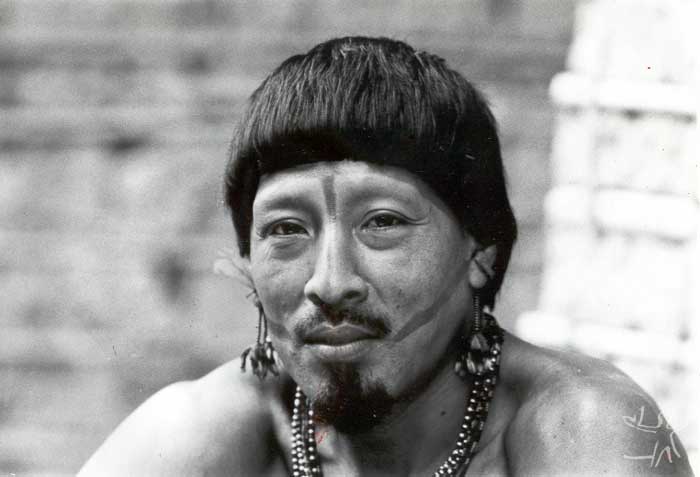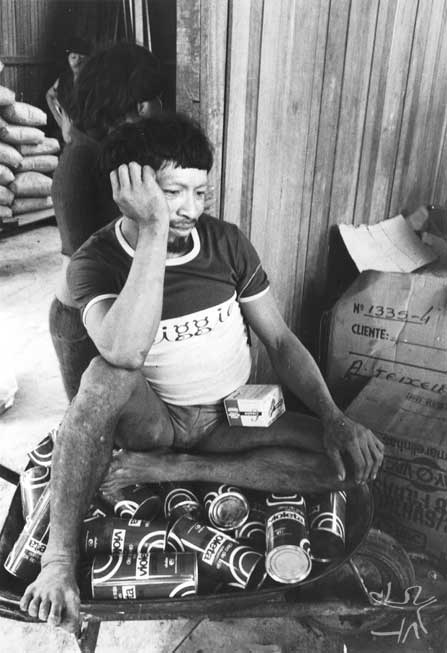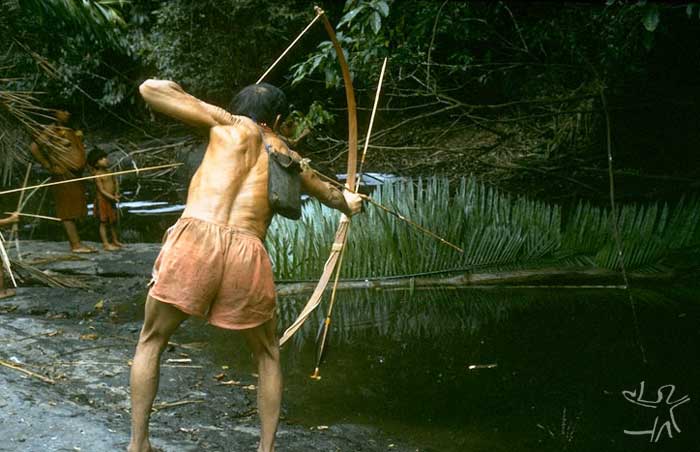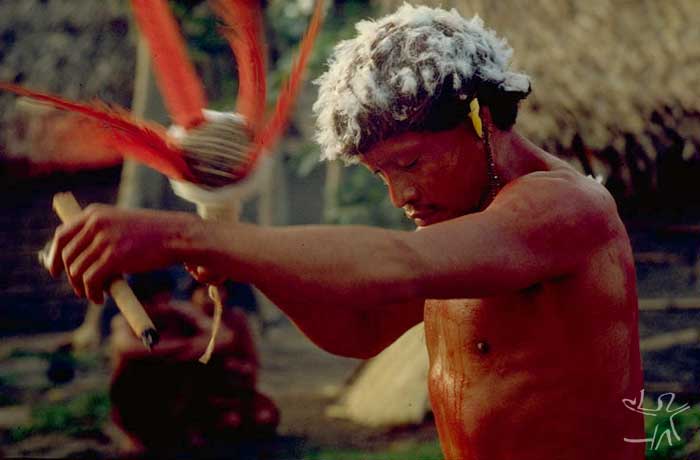Araweté
- Self-denomination
- Bïde
- Where they are How many
- PA 568 (Siasi/Sesai, 2020)
- Linguistic family
- Tupi-Guarani
The Araweté are a Tupi-Guarani people of hunters and terra firme forest gatherers which moved forty years ago from the headsprings of the Bacajá river to the Xingu river, in the state of Pará.
Name and Language
Name
The name "Araweté," invented by a Funai woodsman, means nothing in the group’s language. The only word which could be taken as self-determination is bïde, which means "we," "our people," "human beings." All humans are bïde, but humans par excellence are the Araweté. The other indigenous peoples and the whites (kamarã) are awi, the "strangers" or "the enemy."
Language
The Araweté language belongs to the great Tupi-Guarani family. It is not an easy-to-learn language: its prosody is heavily nasal, the pace is quick and there are sounds which are difficult for the native Portuguese speaker to replicate. Syntax and morphology are quite different than those of Indo-European languages: there are several series of personal pronouns, there are verbal phrases which have no Portuguese equivalent. On the other hand, it is easy to recognize in the Araweté language the legacy of a number of words that Tupi-Guarani left to Brazilian Portuguese, be it in common vernacular, be it in regional jargon, be it in names of places.
The adult Araweté population is practically monolingual: only the young born prior to or immediately following contact understand and speak a little Portuguese. Within a few years, however, most Araweté will be bilingual.
Location and population

The Araweté live in the Southern region of the state of Pará, in a single village, on the banks of Igarapé Ipixuna, a right bank tributary to the middle Xingu river. The Ipixuna is a black water, rapid-packed river flowing over a rock bed bound Southeast / Northwest. The prevailing vegetation in the Ipixuna basin is the open forest with palms, where trees rarely exceed 75 feet. Around the village there are extensive areas of "liana forests", where lianas and thorny plants make progress difficult. The ground is rife with granitic outcroppings covered by cacti, bromeliads and century plants.
The Araweté claim to live "on the edge of the earth:" their tradition tells of successive movements from some Eastern spot (the center of the earth), always fleeing from more powerful enemies.
All that could be ascertained is that they have lived for many years, perhaps centuries, in the forest region between the mid Xingu and Tocantins rivers.
The Araweté live in the Araweté/Igarapé Ipixuna Indigenous Land, in the state of Pará.
The Araweté were 278 individuals in 2000, more than twice as many as surveyed by The Brazilian Federal Agency for Indian Affairs (Funai)'s first census (120 individuals) made in March 1977, when 36% of the population contacted a year earlier died of attacks from the Parakanã and, mainly, of diseases caught during contact with whites.
Contact history

The Araweté history has been, at least since the beginning of the century, one of successive conflicts with enemy tribes and constant moves. They left the Upper Bacajá because of Kayapó and Parakanã attacks. The Araweté, in turn, upon arriving at the Ipixuna and other rivers of the region (Bom Jardim, Pinhaquara) drove the Asurini, who had settled there, away to the Ipiaçava river, up North aways. In 1970, following the construction of the Trans-Amazon highway, which ran through Altamira (the nearest city), the Brazilian government began an effort to attract and pacify the indigenous groups in the mid Xingu region. The Araweté began to be officially noted in 1969. By 1971 Funai established the Ipixuna Attraction Front, which maintained off and on contacts with the Araweté until 1974, without ever visiting their villages. By that time the group was divided into two blocks of villages, one farther to the South, in the Bom Jardim watershed and another to the North, at the Upper Ipixuna.
By January 1976, Parakanã attacks prompted the Araweté from both regions to seek the Xingu banks, intent on "taming" the whites -- since they never thought they were "pacified" by the whites, but rather the other way round. Funai found them in May of the same year, precariously camped near fields, starving and sick due to contact with the whites in the beiradão - as the lands on the Xingu banks are called by regional populations.
By July, Funai’s frontiersmen decide to move this sick, wretched population on a trek to a station built in the Upper Ipixuna, near the old villages of the group. It was a 100 km walk, which took 17 days and at least 66 persons died en route. With their eyes shut by infectious conjunctivitis caught in the beiradão, people could not see their way, were lost in the woods and starved to death; little children, suddenly orphaned, were sacrificed by adults in despair; many people, too weak to walk, asked to be left behind to die in peace.

How many people started the trek is not known, but only 27 arrived together with the woodsmen who led the way; the remainder trickled in later. Some Indians detoured to older villages along the way; a new Parakanã attack drove the entire Araweté who survived trek and foe to gather at the Funai Station. In March 1977, Funai’s first census tagged 120 individuals. The Araweté listed the names of 77 individuals who disappeared in the period between their arrival in the Xingu, in January 1976 and their arrival at the old station in July of the same year; three succumbed to the Parakanã and 73, therefore, perished from contact and the disastrous trek: 36% of the entire population at the time.
In 1978, the group moved, together with the Funai Station, to a site closer to the mouth of the Ipixuna river, where they reside to this date.
Bow, rattle and women's clothes

Despite the Araweté’s material austerity, they manufacture three technically elaborate objects, which are unique to them: the bow, the shaman’s aray rattle and women’s clothes.
The Araweté bow is made of ipê wood and is shorter, broader and more curved than most Brazilian indigenous bows. Each ipê log can yield a number of bows. The wood used to be worked with bone and stone tools (now, with axes and machetes), trued with a cotia tooth chisel, sanded with a coarse leaf until completely smooth and finally carefully warmed over the fire and bowed to shape. Babassu coconut oil or this palm tree’s grub’s fat are used to make the wood more pliable. The bowstring is made from curauá, a cultivated bromeliad.
The shaman aray rattle is an inverted cone braided with arumã strips, covered with cotton twine until only the upper part is visible -- the base of the cone. A cotton boll is stretched around the base as a collar, into it four or five red arara feathers are inserted, giving the object the seeming of a flaming torch. Pieces of ground snail’s shell are inserted inside the braided cone. The aray gives forth a continuous, rasping sound; it is used by shamans to counterpoint the Mai chants and to perform a series of mystical and therapeutic operations: to bring the gods and the souls of the dead back to earth to participate in feasts; to show the way to sick people’s lost souls and to aid in the treatment of wounds and poisonous bites.

During the manufacture of a bow, men are not supposed to indulge in sexual intercourse with their wives, lest the wood crack. The rattle, however, is braided by women, and the cotton covering is done by men. However, once ready, the aray cannot be used by women; a very powerful instrument, it evokes the Mai, who can break the neck of the woman who dared call them. In this society, only men are shaman.
The aray is the only object made by males which cannot be inherited by anyone; following the death of its owner, it must be burned. Endowed with deep symbolic values, it is a personal, non-transferable object.
This sexually branded, personal and intimate character of the aray has its analog among female objects: the internal waistband worn by all women after puberty also is not inherited by anyone, contrarily to external pieces of apparel. The traditional Araweté comprises four pieces: the waistband, a small tube of thick cotton canvas about 25 cm long which covers the genitals and the upper part of the thighs, binding them tightly and propping women into a peculiar gait; a broad armsling to carry their children, which is also worn even by childless young women and a headcloth, a tubular piece as the other female clothes, with the same broad ward and woof of skirt and armsling. Female clothing is woven in simple looms: two babassu leaf spindles stuck perpendicularly into the ground, and dyed with urucum. They consume an awesome amount of cotton; just as men spend a major part of their time manufacturing and repairing their weapons, women dedicate many hours of the day to the process of yarning for their clothes and hammocks. There is always someone at the village weaving a piece of cloth or a hammock.
Since their tender age women wear their outer skirt; at the age of seven, they also carry their armslings and sometimes their headcloths. The waistband is imposed on them from their first menses - one of its purposes is to absorb menstrual blood - and must never be removed in the face of men other than husband or lover, and even so for sexual purposes only. Even among women decency demands that a woman does not stand without the waistband: during the women’s collective bath they usually squat on their haunches when out of the water. Men display equal feelings of decency when removing their foreskin strings when in the presence of others: for the Araweté, nudity is the absence of the female waistband or the foreskin string.
Material culture

The Araweté possess a very simple material culture within the Tupi-Guarani horizon. This can be partially explained by their state of constant alert and flight from foes in the past few decades and partially by contact trauma. In its simplicity itself, the material culture of the Araweté does not allow for approximation to any other particular Tupi-Guarani group. The absolute prevalence of maize cultivation compared to cassava also sets the Araweté apart from other Amazonian Tupi-Guarani.
The men carry a thick beard, which they grow in a goatee; they go naked except for a length of string tied to their foreskins. The women wear an outfit made of four tube-like pieces (waistband, skirt, an armsling-blouse and a headcloth) woven from native cotton and dyed with urucum. They wear earrings made from arara feathers fashioned in flower-like arrangements, pendantifs of iñã beadstrings, as well as necklaces made of the same bead. The men wear the selfsame earrings, however shorter.
Their hair is cut straight across the forehead to the ears, whence it grows to the back of the neck of the men and the shoulder blades of the women.The basic color and dye of the Araweté is the blood-red urucum, with which they cover their hair and bodies, anointing themselves uniformly. They may, however, draw a single horizontal line across their faces at the eyebrow level; one along their noses and one line each from their ears to the corner of their mouths. This pattern is also used in their festive decoration, when it is drawn in perfumed resin and covered with the minuscule bright blue plumage of the cotinga bird. The harpy’s plumes are glued to their hair.
Sources of information
- ARAÚJO, Ana Valéria (Org.). A defesa dos direitos indígenas no judiciário : ações propostas pelo Núcleo de Direitos Indígenas. São Paulo : Instituto Socioambiental, 1995. 544 p.
- ARNAUD, Expedito. Mudanças entre os grupos indígenas Tupi da região do Tocantins-Xingu (Bacia Amazônica). In: --------. O índio e a expansão nacional. Belém : Cejup, 1989. p. 315-64. Publicado originalmente no Boletim do MPEG, Antropologia, Belém, n.s., n. 84, abr. 1983.
- --------. Notícia sobre os índios Araweté, rio Xingu, Pará. Boletim do MPEG: Série Antropologia, Belém : MPEG, n.71, 23 p., 1978.
- AZEVEDO, Sarah et al. Studio dei sistemi eritrocitari ABO, CDE, KELL e LE(a) nella tribu di indions Araweté del Brasile. Antropologia Contemporanea, Firenze : s.ed., v. 15, n. 34, p. 95-9, 1992.
- BALÉE, William. Cultura e vegetação da Amazônia brasileira. In: NEVES, Walter (Org.). Biologia e ecologia humana na Amazônia : avaliação e perspectivas. Belém : MPEG, 1989. p.95-109. (Coleção Eduardo Galvão)
- --------. The culture of Amazonian forests. In: POSEY, D. A.; BALÉE, William (Eds.). Resource management in Amazonia : indigenous and folk strategies. New York : NYBG, 1989. p.1-29. (Advances in Economic Botany, 7)
- --------. Evidence for the sucessional status of liana Forest (Xingu River Basin, Amazonian Brazil). Biotropica, s.l. : s.ed., v.22, n.1, p.36-47, 1990.
- --------. Indigenous adaptation to Amazonian palm forests. Principes: Journal of the Palm Society, s.l. : Palm Society, v.32, n.2, p.47-54, 1988.
- --------. Peoples of the fallow : a historical ecology of foraging in lowland South America. In: REDFORD, Kent; PADOCH, Christine (Orgs.). Conservation of neotropical forests : working from traditional resource use. New York : Columbia University Press, 1992. p.35-57.
- --------; MOORE, Denny. Similarity and variation in plant names in five Tupi-Guarani languages (Eastern Amazonia). Bulletin of the Florida Museum of Natural History: Biological Sciences, s.l. : Florida Museum of Natural History, v.35, n.4, p.209-62, 1991.
- COHN, Clarice; SZTUTMAN, Renato. O visível e o invisível na guerra ameríndia. Sexta Feira: Antropologia, Artes e Humanidades, São Paulo : Pletora, n. 7, p. A43-A56, 2003.
- COMBES, Isabelle. Etre ou ne pas être. A propôs d’Araweté: os deuses canibais d’Eduardo Viveiros de Castro. Journal de la Société des Américanistes, Paris : Société des Américanistes, v.72, p.211-20, 1986.
- CEDI. Programa "Povos Indígenas no Brasil". Araweté : visão de um povo Tupi da Amazônia - Uma exposição multimeios. São Paulo : Cedi, 1992. 16 p.
- ETNOGRAFISK MUSEUM. Peoples of the rainforest : Efe, Chewong, Araweté. Oslo : Etnografisk Museum, 1992. 48 p. (Catálogo de Exposição)
- LOPES, Pedro Alvim Leite. As metamorfoses do corpo : os xamanismos Araweté, Bororo e Tukano a luz do pespectivismo. Rio de Janeiro : UFRJ-Museu Nacional, 2001. (Dissertação de Mestrado)
- MATUCK, Rubens. O Gavião. São Paulo : Ática, 1992.
- --------. Pescaria. São Paulo : Ática, 1992. 16 p. (História da Floresta)
- MILTON, Katharine. Comparative aspects of diet in Amazônia Forest-dwellers. Philosophical Transaction of the Royal Society of London, Londres : Royal Society of London, n.334, p.253-63, 1991.
- RIBEIRO, Berta. Araweté : a índia vestida. Rev. de Antropologia, São Paulo : USP, v.26, 38 p., sep., 1983.
- --------. História do contato do povo Araweté. Porantim, Brasília : Cimi, v.4, n.34, p.14-5, 1981.
- --------. Tecelãs tupi do Xingu. Rev. de Antropologia, São Paulo : USP, v.27/28, p.355-402, 1984/1985.
- RISERIO, Antônio. Palavras canibais. Rev. USP, São Paulo : USP, n. 13, p. 26-43, mar./mai. 1992.
- TEIXEIRA, Cláudia Silva; VIVEIROS DE CASTRO, Eduardo. Fitofisionomia da Área Indígena Araweté-Igarapé Ipixuna, Médio Xingu, Pará (estudo preliminar, acrescido de comentários antropológicos). São Paulo : PIB/CEDI, 1992. 41 p.
- VIVEIROS DE CASTRO, Eduardo. Os Araweté. In: SANTOS, Leinad Ayer O.; ANDRADE, Lúcia M. M. de (Orgs.). Hidrelétricas do Xingu e os povos indígenas. São Paulo : CPI-SP, 1988. p.179-84.
- --------. Araweté : o povo do Ipixuna. São Paulo : Cedi, 1992. 192 p.
- --------. Araweté : os deuses canibais. Rio de Janeiro : Jorge Zahar, 1986. 744 p.
- --------. Araweté : Uma visão da cosmologia e da pessoa. Rio de Janeiro : UFRJ-Museu Nacional, 1984. 664 p. (Tese de Doutorado)
- --------. Os deuses canibais : a morte e o destino da alma entre os Araweté. Rev. de Antropologia, São Paulo : USP, v.27/28, p.55-90, 1984/1985.
- --------. Escatologia pessoal e poder entre os Araweté. Religião e Sociedade, Rio de Janeiro : Iser, v.13, n.3, p.2-26, 1986.
- --------. From the enemy's point of view : humanity and divinity in an Amazonian society. Chicago : Univ. of Chicago Press, 1992. 407 p.
- --------. A inconstância da alma selvagem : e outros ensaios de antropologia. São Paulo : Cosac & Naify, 2002. 552 p.
- --------. Le meurtrier et son double chez les Arawete (Bresil) : un example de fusion rituelle. In: CARTRY, M.; DETIENNE, M. (Orgs.). Destins de Meurtriers. Paris : EPHE/CNRS, 1996. p. 77-104.
- --------. O tempo do jaboti. In: RICARDO, Carlos Alberto (Ed.). Povos Indígenas no Brasil : 1987/88/89/90. São Paulo : Cedi, 1991. p. 344-6. (Aconteceu Especial, 18)
- --------; ANDRADE, Lúcia M. M. de. Os povos indígenas do Médio Xingu. In: SANTOS, Leinad Ayer O.; ANDRADE, Lúcia M. M. de (Orgs.). Hidrelétricas do Xingu e os povos indígenas. São Paulo : CPI-SP, 1988. p.135-45.
- Araweté, povo do Ipixuna. Dir.: Murilo Santos. Vídeo Cor, VHS, 30 min, 1993. Prod.: Cedi/PIB